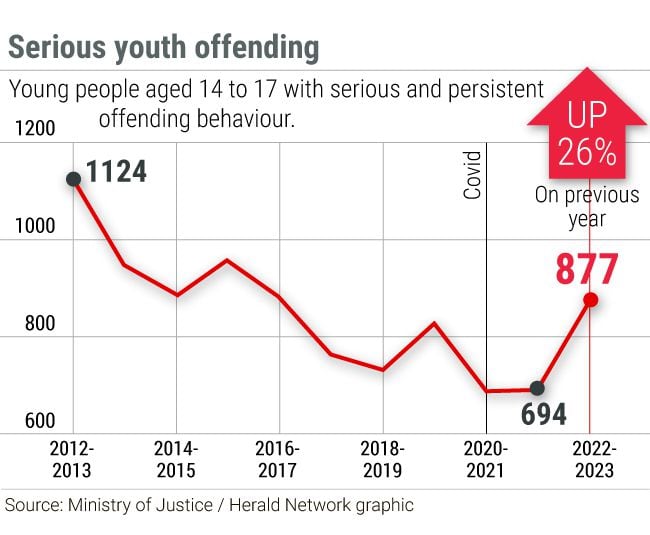Listen live: Andrew Costner joins Newstalk ZB’s Mike Hosking at 7.37am, followed by Mark Mitchell & Ginny Andersen at 8.07am
The latest youth justice statistics show a 26 per cent spike last year in the number of serious young offenders who continue to offend, with the Covid-19 pandemic seen as a contributing factor.
The youth justice indicators - released yesterday by the Ministry of Justice - show 877 young people aged between 14 and 17 identified as “serious and persistent” offenders, the highest number since 2016/17 and well above the previous year (694 such offenders).
The most common offences were burglary/unlawful entry, robbery/extortion and theft, while the number of offenders rose most sharply in Canterbury - where it more than doubled in a year - followed by Northland.
There was also an increase in the number of serious and persistent child offenders (aged between 10 and 13), though the rise was far more modest - 4 per cent from 2021/22 to 2022/23.
This is the first time the numbers for serious and persistent youth offending - added due to Government priorities - have been included in the data. They’ve had at least three police proceedings - ranging from a warning to being charged - within 12 months, with at least one of the offences having a maximum penalty of at least seven years’ jail.
The rising trend underlines the challenge for the Government to turn the sharp increase into a 15 per cent reduction in the number of serious and persistent offenders by 2030 - one of its public service targets.
There has also been a rise in the number of child and youth offenders overall, as well as in the number of police proceedings per capita and reoffending rates among children.
While there has been a steady fall in youth crime statistics over the last 15 years, the numbers reinforce the uptick in the post-pandemic years.
“Drug and alcohol issues, family violence, stress, poverty, intergenerational trauma - those are the driving factors,” said Auckland University Professor Ian Lambie, who is the chief science adviser (justice) to the Prime Minister’s Office.
“A thing like Covid places more stress on all of us, but particularly families with children who couldn’t go to school, were under more financial stress, were isolated from the community. The underlying issues have never gone away, but Covid highlighted them.”

The latest statistics show, for child offenders (aged 10 to 13):
- A 14 per cent increase in the child offender rate (the number of child offenders per 10,000 population) in 2022/23 compared to the previous year - the first increase in over a decade.
- The regions with the highest rates of child offenders were Tasman and the Bay of Plenty, but the biggest annual increases in 2022/23 were in the Canterbury (41 per cent) and Counties Manukau (33 per cent) regions. There was an increase in every region except Northland (down 15 per cent) and Central (down 2 per cent)
- The biggest increases in terms of specific crimes were for robbery/extortion (46 per cent), abduction/harrassment (44 per cent), weapons offences (35 per cent), and causing injury (30 per cent). Dangerous acts were the only category that decreased (down a whopping 64 per cent)
- For “serious and persistent offenders”, there was a 4 per cent rise in the total number nationwide; the numbers ballooned from 9 to 25 children in Canterbury, and more than doubled in Waikato (from 11 to 23) and Wellington (from 9 to 20).
- Burglary/unlawful entry accounted for 40 per cent of crime for serious and persistent offenders, though a diminishing proportion of the total number of offences. Robbery/extortion saw the greatest increase (87 per cent), ahead of abduction/harassment (50 per cent).
 Prime Minister Christopher Luxon has set a target of reducing the number of serious and persistent young offenders by 15 per cent by 2030. Photo / Jason Dorday
Prime Minister Christopher Luxon has set a target of reducing the number of serious and persistent young offenders by 15 per cent by 2030. Photo / Jason Dorday
For youth offenders (aged 14 to 17):
- There was a 9 per cent increase in youth offender rate in 2022/23 compared to the previous year - also the first increase in over a decade.
- The highest increases in the Canterbury (20 per cent), Waitematā and Counties Manukau (17 per cent respectively). Again, there were only two districts where the rate dropped - Northland and Central (each down 4 per cent).
- The biggest spikes were for robbery/extortion (32 per cent), traffic offences (31 per cent), and weapons offences (28 per cent).
- The number of serious and persistent offenders jumped 26 per cent nationwide for 2022/23. In Canterbury, it more than doubled - from 46 to 105 young people - while there was a 61 per cent increase in Northland. Eastern and Central were the only police districts with annual decreases (3 and 4 per cent respectively).
- Robbery/extortion saw the biggest annual increase (67 per cent) among serious and persistent offenders, though the most common offence was burglary/unlawful entry.
The number of per capita police proceedings also increased for both age cohorts: 7 per cent for those aged 10 to 13, and 11 per cent for those aged 14 to 17.
While reoffending rates remained relatively static, the two-year rate for children managed outside the formal justice system increased from 36 to 40 per cent; the biggest increases were for 10- and 11-year-olds.
Not included in the statistics were ram raids, which may have captured crime headlines in recent years but are not a specific offence category. Police have said that the number of ram raids spiked in mid-2022 and have been falling since.
The youth justice numbers are also distinct from justice statistics based on finalised court charges, though both data sets show an increase in recorded youth crime.
 Chief science adviser to the justice sector Ian Lambie launches the Every Four Minutes paper into family violence. Photo / Derek Cheng
Chief science adviser to the justice sector Ian Lambie launches the Every Four Minutes paper into family violence. Photo / Derek Cheng
Lambie said the trend in statistics highlighted the need for early intervention to alter a child’s life course from what he has previous termed the “prison pipeline”, or ”the seemingly inevitable journey from early offending to eventual adult prison”.
“We need a whole whānau and community approach. We need to focus on children under the age of 10 who are potentially the most high-risk of ending up in the Youth Court,” he told the Herald.
“It’s partly a justice response, but it’s really more an education and health response. Education is absolutely key, and obviously health, but a mental health response is key as well.”
The Government has a public service target of a 15 per cent reduction by 2030 in the total number of children and young people with serious and persistent offending behaviour.
Budget 2024 included $28 million over four years – split between Oranga Tamariki, courts, justice and police – for a pilot sending serious repeat young offenders to a boot camp, expected to start in the middle of this year and to be run by Oranga Tamariki.
The policy has been described as regurgitating a failed experiment, though the Government says they will be better than previous iterations; the boot camps from the last National-led Government had re-offending rates at more than 80 per cent.
The Government is also pursuing Social Investment 2.0, which aims to use data to target our most vulnerable with early, locally-delivered interventions to alter one’s life course away from the wrong side of the tracks.
Derek Cheng is a senior journalist who started at the Herald in 2004. He has worked several stints in the press gallery and is a former deputy political editor.
Take your Radio, Podcasts and Music with you








